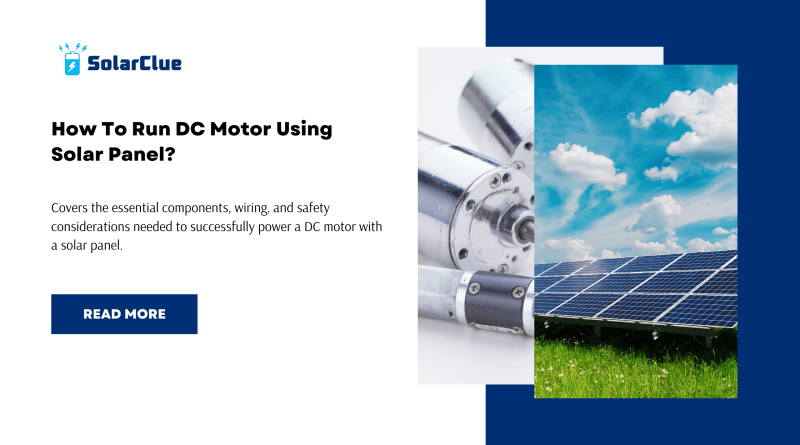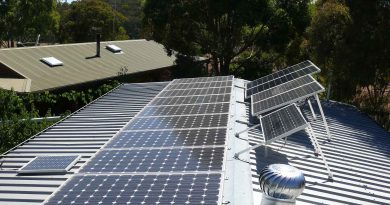How To Run DC Motor Using Solar Panel?
Running a DC motor using solar power is an efficient and eco-friendly solution for various applications, from small DIY projects to larger industrial uses. This blog covers the essential components, wiring, and safety considerations needed to successfully power a DC motor with a solar panel.
Table of Contents
- 1 Understanding DC Motors and Their Specifications
- 1.1 Choosing the Right Solar Panel for Your Motor
- 1.2 The Role of a Charge Controller
- 1.3 Wiring Diagrams and Connection Procedures
- 1.4 Optimizing Motor Performance with Solar Power
- 1.5 Battery Storage for Consistent Motor Operation
- 1.6 Troubleshooting Common Issues
- 1.7 Safety Guidelines for Working with Electricity
- 1.8 Advanced Applications of Solar-Powered Motors
- 1.9 The Future of Solar-Powered Electric Motors
- 1.10 Example Component Specifications for a Small Solar-Powered DC Motor System
- 1.11 Conclusion
Understanding DC Motors and Their Specifications
DC motors convert direct current (DC) electrical energy into mechanical energy. They are commonly used in applications like fans, pumps, conveyors, and electric vehicles. Key specifications to consider include:
- Voltage Rating: The voltage required to operate the motor, typically ranging from 6V to 48V.
- Current Rating: The amount of current (in amps) the motor draws under normal operation.
- Power Rating: The total power consumption, calculated as voltage multiplied by current (W = V × A).
- Speed (RPM): The rotational speed of the motor, measured in revolutions per minute.
Choosing the Right Solar Panel for Your Motor
The solar panel must be capable of providing the necessary voltage and current to operate the motor efficiently. Key considerations include:
- Voltage Compatibility: Ensure the solar panel’s voltage matches the motor’s voltage rating.
- Current Capacity: The solar panel should provide enough current to meet or exceed the motor’s current requirements.
- Power Output: The panel’s wattage should be equal to or greater than the motor’s power consumption.
The Role of a Charge Controller
A charge controller regulates the voltage and current coming from the solar panel to the motor. It ensures that the motor receives a consistent voltage and prevents overloading or damaging the motor.
- Types of Charge Controllers: PWM (Pulse Width Modulation) and MPPT (Maximum Power Point Tracking) controllers are commonly used.
- Voltage Regulation: The controller helps maintain a stable voltage output from the solar panel, crucial for motor operation.
Wiring Diagrams and Connection Procedures
Proper wiring and connections are essential for the safe and efficient operation of the motor. Below is a general step-by-step procedure:
Gather Components: Solar panel, DC motor, charge controller, wires, and optional battery.
Connect Solar Panel to Charge Controller: Wire the positive and negative terminals of the solar panel to the corresponding inputs on the charge controller.
Connect Charge Controller to Motor: Wire the motor’s terminals to the charge controller’s output terminals.
Optional – Add Battery Storage: If using a battery, connect it between the charge controller and the motor to store excess energy.
Wiring Diagram:
- Solar Panel (positive) → Charge Controller (input positive)
- Solar Panel (negative) → Charge Controller (input negative)
- Charge Controller (output positive) → Motor (positive)
- Charge Controller (output negative) → Motor (negative)
- Optional Battery (connected in parallel with the motor)
Optimizing Motor Performance with Solar Power
To maximize the performance of your DC motor when powered by solar energy:
- Use an MPPT Controller: This type of controller optimizes the power output from the solar panel, ensuring the motor receives the most efficient energy supply.
- Minimize Power Loss: Use short, thick wires to reduce resistance and power loss between components.
- Positioning the Solar Panel: Ensure the panel is placed in an area with maximum sunlight exposure, and consider using a solar tracker for dynamic adjustment.
Battery Storage for Consistent Motor Operation
A battery can store excess energy generated by the solar panel, ensuring the motor operates consistently, even when sunlight is low.
- Battery Type: Choose a deep-cycle battery with a voltage that matches the motor and solar panel.
- Battery Capacity: The capacity should be sufficient to power the motor during non-sunny periods.
Troubleshooting Common Issues
Common issues that might arise include:
- Motor Not Running: Check connections, ensure the solar panel is generating sufficient power, and verify that the charge controller is functioning.
- Low Performance: Ensure the solar panel is receiving adequate sunlight, and consider cleaning the panel surface to remove dirt and debris.
- Overheating: Ensure the motor is not drawing more current than the solar panel and controller can provide. Check for adequate ventilation.
Safety Guidelines for Working with Electricity
When working with solar panels and DC motors, follow these safety guidelines:
- Use Proper Insulation: Ensure all wires are properly insulated to prevent short circuits.
- Disconnect Power Before Wiring: Always disconnect the solar panel from the system before making any connections or adjustments.
- Use Fuses and Circuit Breakers: Protect your system with appropriate fuses and circuit breakers to prevent overloads.
Advanced Applications of Solar-Powered Motors
Solar-powered DC motors can be used in a variety of advanced applications:
- Solar-Powered Water Pumps: Used in irrigation and water supply systems, especially in remote areas.
- Solar-Powered Fans and Ventilation Systems: Ideal for off-grid cooling and ventilation solutions.
- Solar Electric Vehicles: DC motors powered by solar panels are increasingly used in electric vehicle applications.
The Future of Solar-Powered Electric Motors
As solar technology advances, the efficiency and applicability of solar-powered motors will continue to grow:
- Improved Solar Panels: New materials and technologies will increase the efficiency and reduce the cost of solar panels.
- Smart Controllers: Future charge controllers will feature enhanced algorithms for better energy management.
- Integration with IoT: Solar-powered motors will be integrated into the Internet of Things (IoT) for remote monitoring and control.
Example Component Specifications for a Small Solar-Powered DC Motor System
| Component | Specification |
|---|---|
| DC Motor | 12V, 2A, 24W, 1500 RPM |
| Solar Panel | 12V, 50W |
| Charge Controller | 12V, 5A PWM |
| Battery (optional) | 12V, 20Ah Deep Cycle Battery |
| Wiring | 14 AWG Copper Wire |
| Fuses | 5A Inline Fuse |
Conclusion
Running a DC motor using a solar panel is a sustainable and cost-effective solution for various applications. By carefully selecting and matching components, wiring them correctly, and following safety precautions, you can create an efficient solar-powered motor system. As technology evolves, the potential for solar-powered motors will only increase, paving the way for more innovative applications.
Here at SolarClue®, we offer a smart, practical, and “beautiful” solution. You will be answered for all the questions related to Solar.
We provide all kinds of brands that are the Best Solar panels in India.
If you are the one who is planning for the solar power system. Don’t hesitate to contact our team!
Looking forward to empowering you with solar energy, just like hundreds of our other clients!




5Hp. DC Mother how many soler panel required for water pump delivery 4 inch water level 30 feet
To power a 5 HP DC water pump, you’ll need around 12-15 solar panels (300-400W each) to meet the 4500W requirement efficiently.